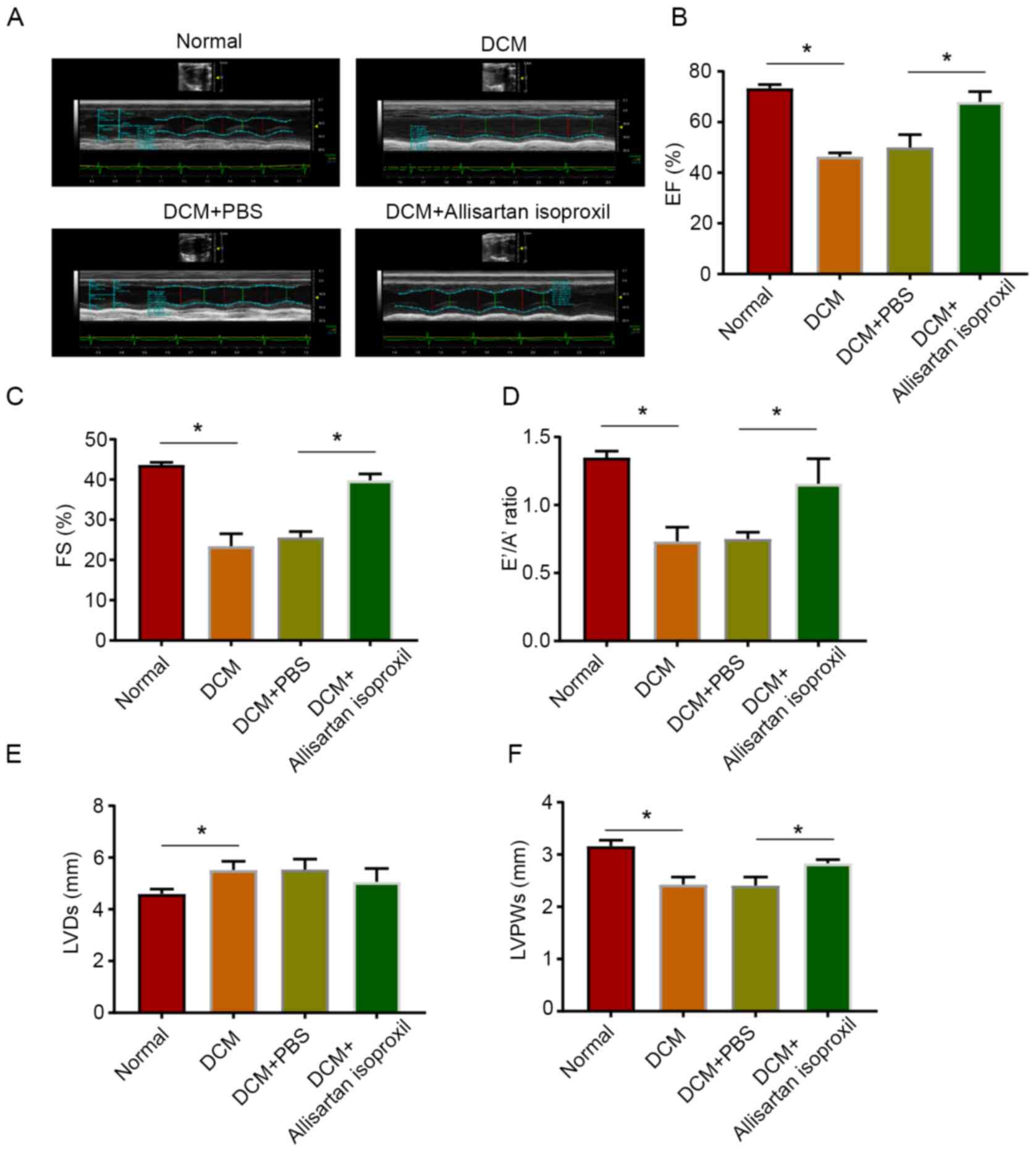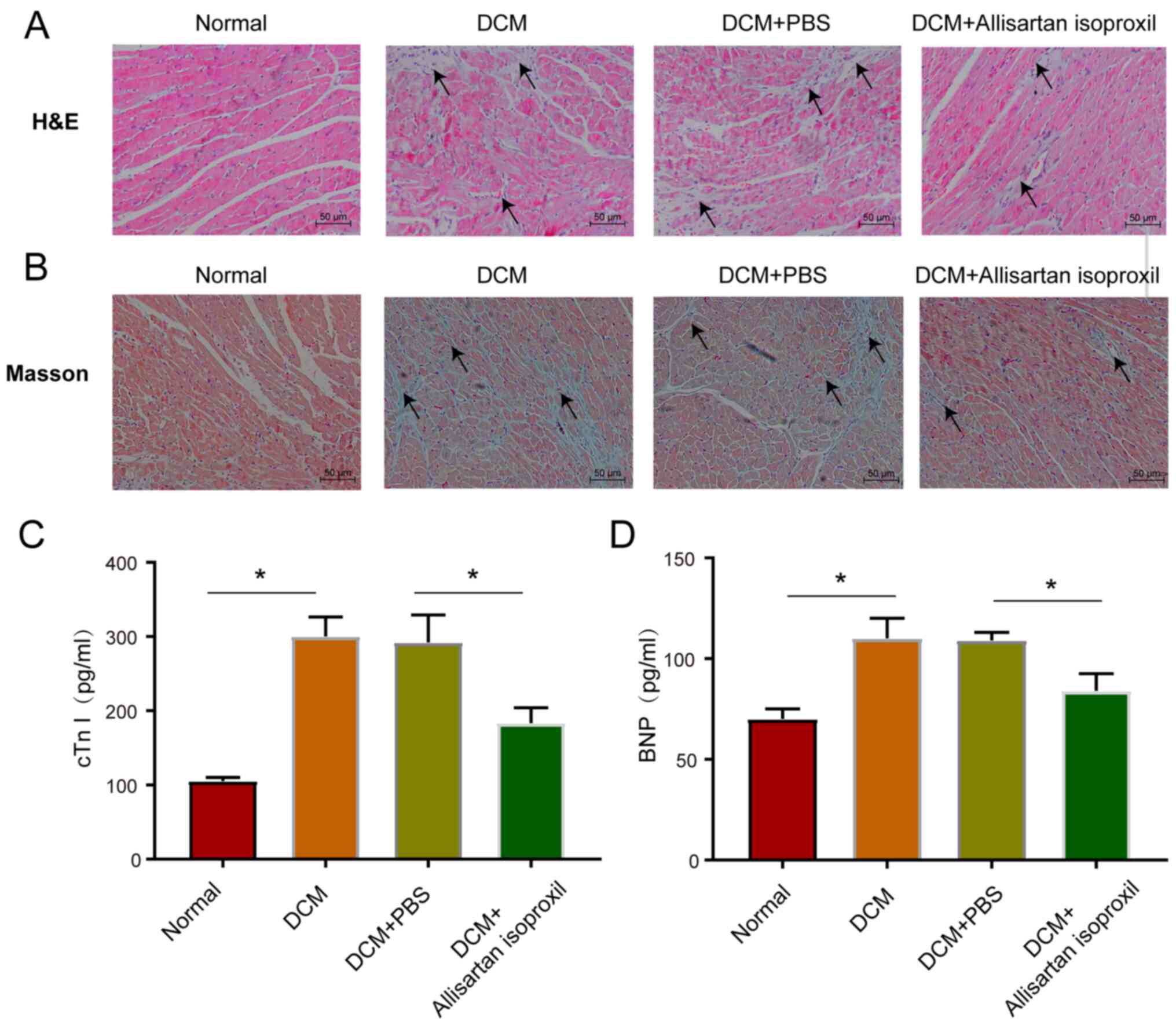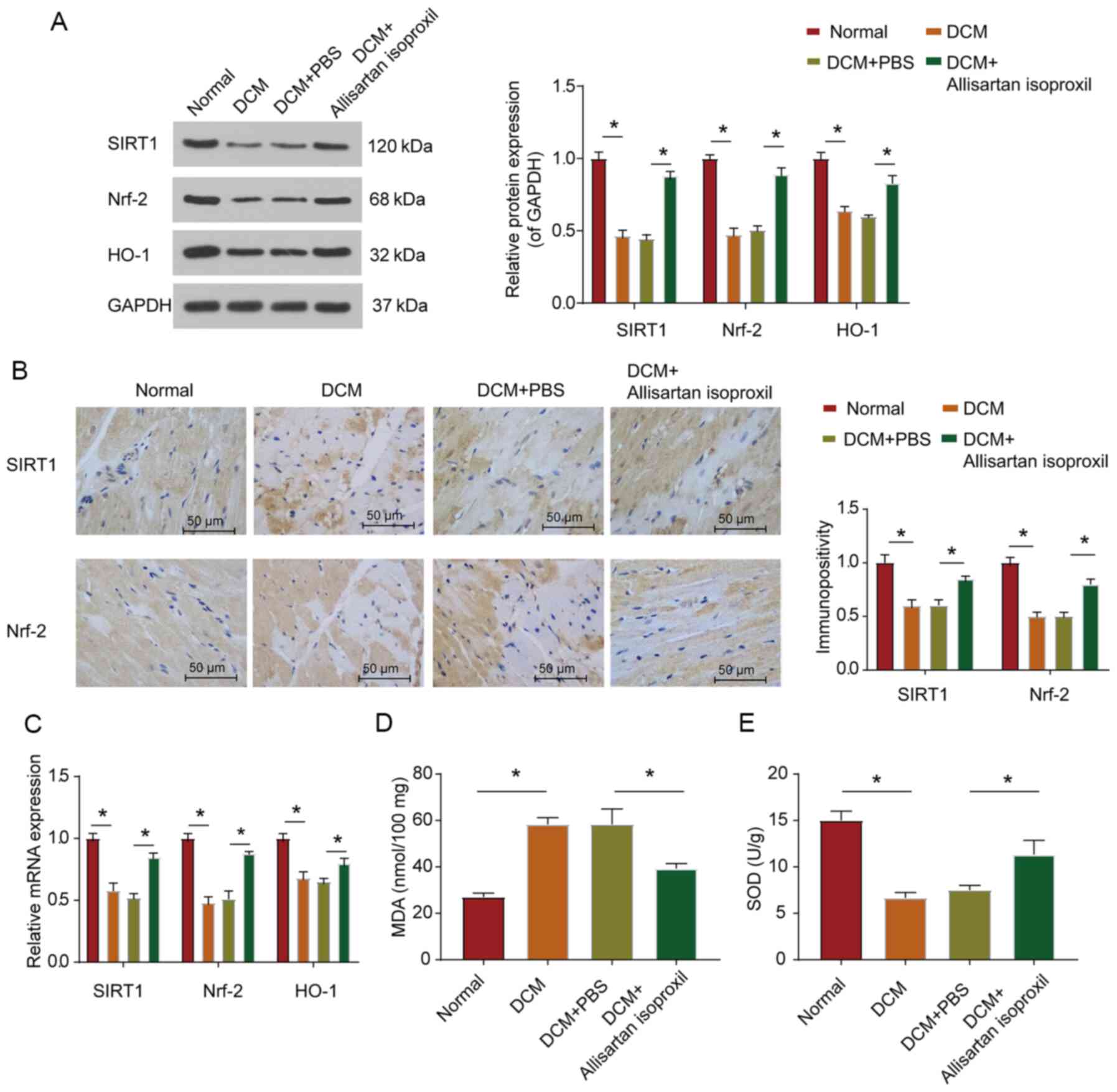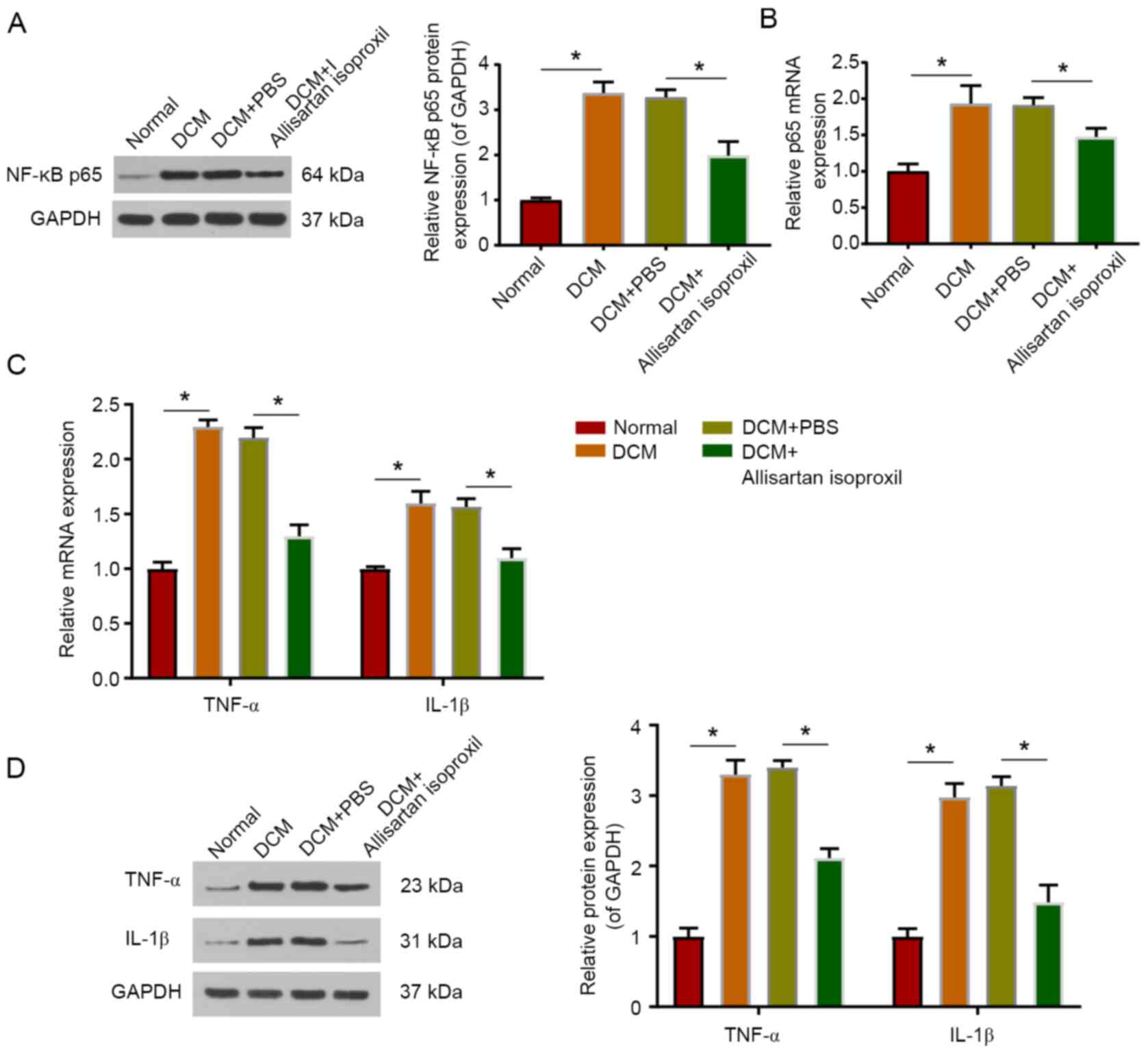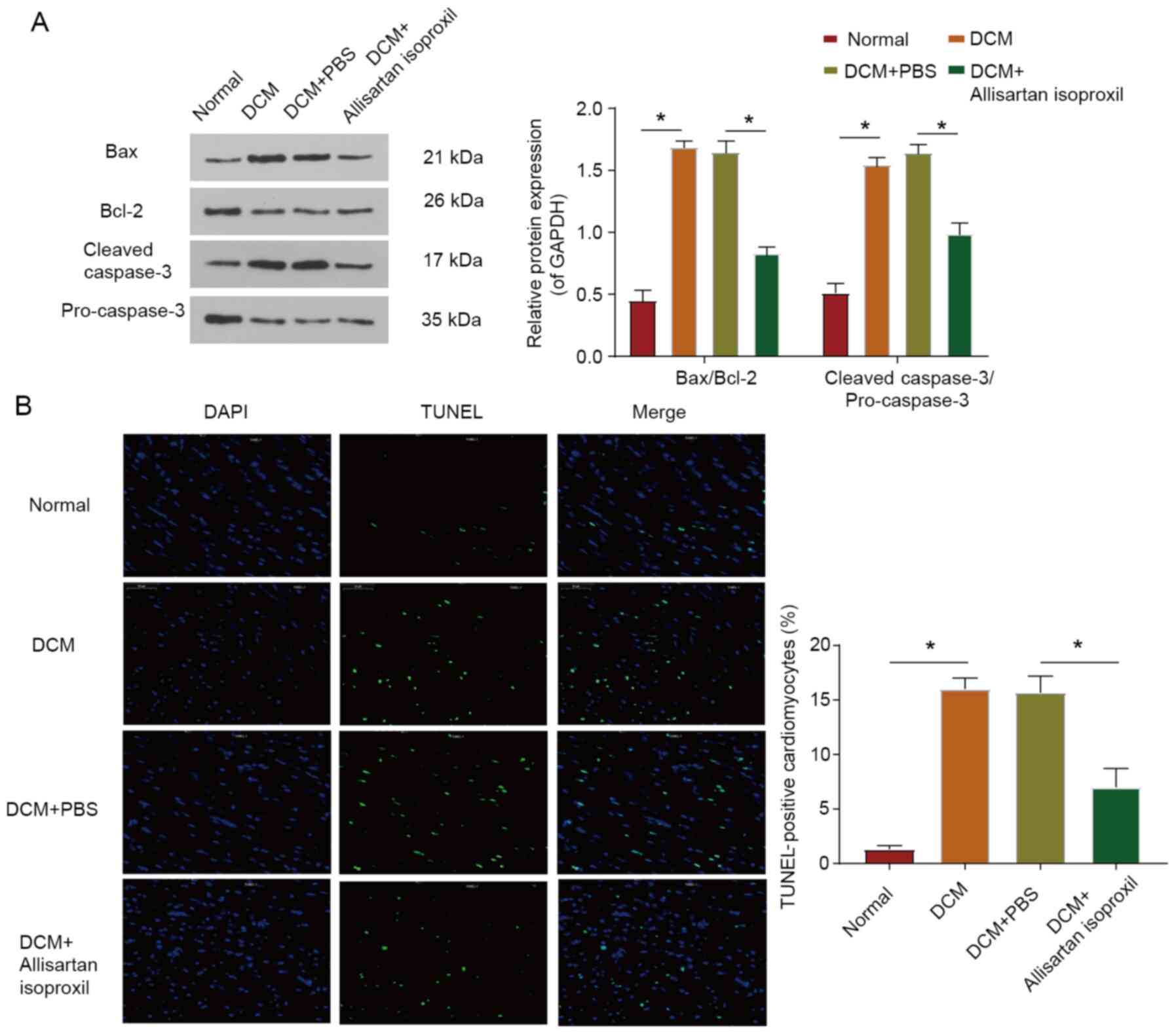|
1
|
Whiting DR, Guariguata L, Weil C and Shaw
J: IDF diabetes atlas: Global estimates of the prevalence of
diabetes for 2011 and 2030. Diabetes Res Clin Pract. 94:311–321.
2011. View Article : Google Scholar : PubMed/NCBI
|
|
2
|
Liu X, Xiao J, Zhu H, Wei X, Platt C,
Damilano F, Xiao C, Bezzerides V, Boström P, Che L, et al: miR-222
is necessary for exercise-induced cardiac growth and protects
against pathological cardiac remodeling. Cell Metab. 21:584–595.
2015. View Article : Google Scholar : PubMed/NCBI
|
|
3
|
Tribouilloy C, Rusinaru D, Mahjoub H,
Tartière JM, Kesri-Tartière L, Godard S and Peltier M: Prognostic
impact of diabetes mellitus in patients with heart failure and
preserved ejection fraction: A prospective five-year study. Heart.
94:1450–1455. 2008. View Article : Google Scholar : PubMed/NCBI
|
|
4
|
Devereux RB, Roman MJ, Paranicas M,
O'Grady MJ, Lee ET, Welty TK, Fabsitz RR, Robbins D, Rhoades ER and
Howard BV: Impact of diabetes on cardiac structure and function:
The strong heart study. Circulation. 101:2271–2276. 2000.
View Article : Google Scholar : PubMed/NCBI
|
|
5
|
Howard BV, Cowan LD, Go O, Welty TK,
Robbins DC and Lee ET: Adverse effects of diabetes on multiple
cardiovascular disease risk factors in women. The Strong Heart
Study. Diabetes Care. 21:1258–1265. 1998. View Article : Google Scholar : PubMed/NCBI
|
|
6
|
Ma ZG, Yuan YP, Xu SC, Wei WY, Xu CR,
Zhang X, Wu QQ, Liao HH, Ni J and Tang QZ: CTRP3 attenuates cardiac
dysfunction, inflammation, oxidative stress and cell death in
diabetic cardiomyopathy in rats. Diabetologia. 60:1126–1137. 2017.
View Article : Google Scholar : PubMed/NCBI
|
|
7
|
Zhou X, An G and Lu X: Hydrogen sulfide
attenuates the development of diabetic cardiomyopathy. Clin Sci
(Lond). 128:325–335. 2015. View Article : Google Scholar : PubMed/NCBI
|
|
8
|
Zhao MX, Zhou B, Ling L, Xiong XQ, Zhang
F, Chen Q, Li YH, Kang YM and Zhu GQ: Salusin-β contributes to
oxidative stress and inflammation in diabetic cardiomyopathy. Cell
Death Dis. 8:e26902017. View Article : Google Scholar : PubMed/NCBI
|
|
9
|
Rajesh M, Bátkai S, Kechrid M,
Mukhopadhyay P, Lee WS, Horváth B, Holovac E, Cinar R, Liaudet L,
Mackie K, et al: Cannabinoid 1 receptor promotes cardiac
dysfunction, oxidative stress, inflammation, and fibrosis in
diabetic cardiomyopathy. Diabetes. 61:716–727. 2012. View Article : Google Scholar : PubMed/NCBI
|
|
10
|
Rajesh M, Mukhopadhyay P, Bátkai S, Patel
V, Saito K, Matsumoto S, Kashiwaya Y, Horváth B, Mukhopadhyay B,
Becker L, et al: Cannabidiol attenuates cardiac dysfunction,
oxidative stress, fibrosis, and inflammatory and cell death
signaling pathways in diabetic cardiomyopathy. J Am Coll Cardiol.
56:2115–2125. 2010. View Article : Google Scholar : PubMed/NCBI
|
|
11
|
Duecker R, Baer P, Eickmeier O, Strecker
M, Kurz J, Schaible A, Henrich D, Zielen S and Schubert R:
Oxidative stress-driven pulmonary inflammation and fibrosis in a
mouse model of human ataxia-telangiectasia. Redox Biol. 14:645–655.
2018. View Article : Google Scholar : PubMed/NCBI
|
|
12
|
Rajasekaran NS, Varadharaj S, Khanderao
GD, Davidson CJ, Kannan S, Firpo MA, Zweier JL and Benjamin IJ:
Sustained activation of nuclear erythroid 2-related factor
2/antioxidant response element signaling promotes reductive stress
in the human mutant protein aggregation cardiomyopathy in mice.
Antioxid Redox Signal. 14:957–971. 2011. View Article : Google Scholar : PubMed/NCBI
|
|
13
|
Gu J, Cheng Y, Wu H, Kong L, Wang S, Xu Z,
Zhang Z, Tan Y, Keller BB, Zhou H, et al: Metallothionein is
downstream of Nrf2 and partially mediates sulforaphane prevention
of diabetic cardiomyopathy. Diabetes. 66:529–542. 2017. View Article : Google Scholar : PubMed/NCBI
|
|
14
|
Lu MC, Ji JA, Jiang ZY and You QD: The
Keap1-Nrf2-ARE pathway as a potential preventive and therapeutic
target: An update. Med Res Rev. 36:924–963. 2016. View Article : Google Scholar : PubMed/NCBI
|
|
15
|
Magesh S, Chen Y and Hu L: Small molecule
modulators of Keap1-Nrf2-ARE pathway as potential preventive and
therapeutic agents. Med Res Rev. 32:687–726. 2012. View Article : Google Scholar : PubMed/NCBI
|
|
16
|
Zhao L, Qi Y, Xu L, Tao X, Han X, Yin L
and Peng J: MicroRNA-140-5p aggravates doxorubicin-induced
cardiotoxicity by promoting myocardial oxidative stress via
targeting Nrf2 and Sirt2. Redox Biol. 15:284–296. 2018. View Article : Google Scholar : PubMed/NCBI
|
|
17
|
Karbasforooshan H and Karimi G: The role
of SIRT1 in diabetic cardiomyopathy. Biomed Pharmacother.
90:386–392. 2017. View Article : Google Scholar : PubMed/NCBI
|
|
18
|
Guo R, Liu W, Liu B, Zhang B, Li W and Xu
Y: SIRT1 suppresses cardiomyocyte apoptosis in diabetic
cardiomyopathy: An insight into endoplasmic reticulum stress
response mechanism. Int J Cardiol. 191:36–45. 2015. View Article : Google Scholar : PubMed/NCBI
|
|
19
|
Huang K, Huang J, Xie X, Wang S, Chen C,
Shen X, Liu P and Huang H: Sirt1 resists advanced glycation end
products-induced expressions of fibronectin and TGF-β1 by
activating the Nrf2/ARE pathway in glomerular mesangial cells. Free
Radic Biol Med. 65:528–540. 2013. View Article : Google Scholar : PubMed/NCBI
|
|
20
|
de Mingo Á, de Gregorio E, Moles A,
Tarrats N, Tutusaus A, Colell A, Fernandez-Checa JC, Morales A and
Marí M: Cysteine cathepsins control hepatic NF-κB-dependent
inflammation via sirtuin-1 regulation. Cell Death Dis. 7:e24642016.
View Article : Google Scholar : PubMed/NCBI
|
|
21
|
Dong B, Yu QT, Dai HY, Gao YY, Zhou ZL,
Zhang L, Jiang H, Gao F, Li SY, Zhang YH, et al:
Angiotensin-converting enzyme-2 overexpression improves left
ventricular remodeling and function in a rat model of diabetic
cardiomyopathy. J Am Coll Cardiol. 59:739–747. 2012. View Article : Google Scholar : PubMed/NCBI
|
|
22
|
Mehta PK and Griendling KK: Angiotensin II
cell signaling: Physiological and pathological effects in the
cardiovascular system. Am J Physiol Cell Physiol. 292:C82–C97.
2007. View Article : Google Scholar : PubMed/NCBI
|
|
23
|
Mori J, Basu R, McLean BA, Das SK, Zhang
L, Patel VB, Wagg CS, Kassiri Z, Lopaschuk GD and Oudit GY:
Agonist-induced hypertrophy and diastolic dysfunction are
associated with selective reduction in glucose oxidation: A
metabolic contribution to heart failure with normal ejection
fraction. Circ Heart Fail. 5:493–503. 2012. View Article : Google Scholar : PubMed/NCBI
|
|
24
|
Wu MY, Ma XJ, Yang C, Tao X, Liu AJ, Su DF
and Liu JG: Effects of allisartan, a new AT(1) receptor blocker, on
blood pressure and end-organ damage in hypertensive animals. Acta
Pharmacol Sin. 30:307–313. 2009. View Article : Google Scholar : PubMed/NCBI
|
|
25
|
Zhang JQ, Yang GH, Zhou X, Liu JX, Shi R,
Dong Y, Chen SB and Li YM: Effects of allisartan isoproxil on blood
pressure and target organ injury in patients with mild to moderate
essential hypertension. Medicine (Baltimore). 98:e149072019.
View Article : Google Scholar : PubMed/NCBI
|
|
26
|
Li Y, Li XH, Huang ZJ, Yang GP, Zhang GG,
Zhao SP, Guo Y, Lu SJ, Ma JL, Meng FB, et al: A randomized, double
blind, placebo-controlled, multicenter phase II trial of Allisartan
Isoproxil in essential hypertensive population at low-medium risk.
PLoS One. 10:e01175602015. View Article : Google Scholar : PubMed/NCBI
|
|
27
|
Os I, Franco V, Kjeldsen SE, Manhem K,
Devereux RB, Gerdts E, Hille DA, Lyle PA, Okin PM, Dahlöf B and
Oparil S: Effects of losartan in women with hypertension and left
ventricular hypertrophy: Results from the Losartan Intervention for
Endpoint Reduction in Hypertension Study. Hypertension.
51:1103–1108. 2008. View Article : Google Scholar : PubMed/NCBI
|
|
28
|
Bokma JP, Winter MM, van Dijk AP, Vliegen
HW, van Melle JP, Meijboom FJ, Post MC, Berbee JK, Boekholdt SM,
Groenink M, et al: Effect of losartan on right ventricular
dysfunction: Results from the double-blind, randomized REDEFINE
Trial (Right ventricular dysfunction in tetralogy of fallot:
Inhibition of the renin-angiotensin-aldosterone system) in adults
with repaired tetralogy of fallot. Circulation. 137:1463–1471.
2018. View Article : Google Scholar : PubMed/NCBI
|
|
29
|
Wang L, Li J and Li D: Losartan reduces
myocardial interstitial fibrosis in DCMrats by inhibiting JAK/STAT
signaling pathway. Int J Clin Exp Pathol. 8:466–473.
2015.PubMed/NCBI
|
|
30
|
Axelsson A, Iversen K, Vejlstrup N, Ho CY,
Havndrup O, Kofoed KF, Norsk J, Jensen M and Bundgaard H:
Functional effects of losartan in hypertrophic cardiomyopathy-a
randomised clinical trial. Heart. 102:285–291. 2016. View Article : Google Scholar : PubMed/NCBI
|
|
31
|
Shimada YJ, Passeri JJ, Baggish AL,
O'Callaghan C, Lowry PA, Yannekis G, Abbara S, Ghoshhajra BB,
Rothman RD, Ho CY, et al: Effects of losartan on left ventricular
hypertrophy and fibrosis in patients with nonobstructive
hypertrophic cardiomyopathy. JACC Heart Fail. 1:480–407. 2013.
View Article : Google Scholar : PubMed/NCBI
|
|
32
|
Carswell CI and Goa KL: Losartan in
diabetic nephropathy. Drugs. 63:407–416. 2003. View Article : Google Scholar : PubMed/NCBI
|
|
33
|
Ti Y, Xie GL, Wang ZH, Bi XL, Ding WY,
Wang J, Jiang GH, Bu PL, Zhang Y, Zhong M and Zhang W: TRB3 gene
silencing alleviates DCMin a type 2 diabetic rat model. Diabetes.
60:2963–2974. 2011. View Article : Google Scholar : PubMed/NCBI
|
|
34
|
Bati K, Kwape TE and Chaturvedi P:
Anti-Diabetic effects of an ethanol extract of cassia abbreviata
stem bark on diabetic rats and possible mechanism of its action:
-Anti-diabetic properties of cassia abbreviata. J Pharmacopuncture.
20:45–51. 2017. View Article : Google Scholar : PubMed/NCBI
|
|
35
|
Zheng D, Zhang Y, Hu Y, Guan J, Xu L, Xiao
W, Zhong Q, Ren C, Lu J, Liang J and Hou J: Long noncoding RNA
Crnde attenuates cardiac fibrosis via Smad3-Crnde negative feedback
in diabetic cardiomyopathy. FEBS J. 286:1645–1655. 2019. View Article : Google Scholar : PubMed/NCBI
|
|
36
|
Ghorbanzadeh V, Mohammadi M, Dariushnejad
H, Chodari L and Mohaddes G: Effects of crocin and voluntary
exercise, alone or combined, on heart VEGF-A and HOMA-IR of HFD/STZ
induced type 2 diabetic rats. J Endocrinol Invest. 39:1179–1186.
2016. View Article : Google Scholar : PubMed/NCBI
|
|
37
|
Hou Y, Shao J, Fu Q, Li J, Sun J and He Z:
Spray-dried nanocrystals for a highly hydrophobic drug: Increased
drug loading, enhanced redispersity, and improved oral
bioavailability. Int J Pharm. 516:372–379. 2017. View Article : Google Scholar : PubMed/NCBI
|
|
38
|
Livak KJ and Schmittgen TD: Analysis of
relative gene expression data using real-time quantitative PCR and
the 2(-Delta Delta C(T)) method. Methods. 25:402–408. 2001.
View Article : Google Scholar : PubMed/NCBI
|
|
39
|
Bai Y, Cui W, Xin Y, Miao X, Barati MT,
Zhang C, Chen Q, Tan Y, Cui T, Zheng Y and Cai L: Prevention by
sulforaphane of DCMis associated with up-regulation of Nrf2
expression and transcription activation. J Mol Cell Cardiol.
57:82–95. 2013. View Article : Google Scholar : PubMed/NCBI
|
|
40
|
Koller WC and Vetere-Overfield B:
Usefulness of a writing aid in writer's cramp. Neurology.
39:149–150. 1989. View Article : Google Scholar : PubMed/NCBI
|
|
41
|
Czarnecka AK, Milewski K and Zielińska M:
Asymmetric dimethylarginine and hepatic encephalopathy: Cause,
effect or association? Neurochem Res. 42:750–761. 2017. View Article : Google Scholar : PubMed/NCBI
|
|
42
|
Roul D and Recchia FA: Metabolic
alterations induce oxidative stress in diabetic and failing hearts:
Different pathways, same outcome. Antioxid Redox Signal.
22:1502–1514. 2015. View Article : Google Scholar : PubMed/NCBI
|
|
43
|
Palomer X, Pizarro-Delgado J and
Vázquez-Carrera M: Emerging actors in diabetic cardiomyopathy:
Heartbreaker biomarkers or therapeutic targets? Trends Pharmacol
Sci. 39:452–467. 2018. View Article : Google Scholar : PubMed/NCBI
|
|
44
|
Zhu Y, Qian X, Li J, Lin X, Luo J, Huang J
and Jin Z: Astragaloside-IV protects H9C2(2-1) cardiomyocytes from
high glucose-induced injury via miR-34a-mediated autophagy pathway.
Artif Cells Nanomed Biotechnol. 47:4172–4181. 2019. View Article : Google Scholar : PubMed/NCBI
|
|
45
|
Tsai TH, Lin CJ, Chua S, Chung SY, Chen
SM, Lee CH and Hang CL: Deletion of RasGRF1 attenuated interstitial
fibrosis in streptozotocin-induced DCMin mice through affecting
inflammation and oxidative stress. Int J Mol Sci. 19:30942018.
View Article : Google Scholar
|
|
46
|
Li L, Luo W, Qian Y, Zhu W, Qian J, Li J,
Jin Y, Xu X and Liang G: Luteolin protects against DCMby inhibiting
NF-κB-mediated inflammation and activating the Nrf2-mediated
antioxidant responses. Phytomedicine. 59:1527742019. View Article : Google Scholar : PubMed/NCBI
|
|
47
|
Biernacka A, Cavalera M, Wang J, Russo I,
Shinde A, Kong P, Gonzalez-Quesada C, Rai V, Dobaczewski M, Lee DW,
et al: Smad3 signaling promotes fibrosis while preserving cardiac
and aortic geometry in obese diabetic mice. Circ Heart Fail.
8:788–798. 2015. View Article : Google Scholar : PubMed/NCBI
|
|
48
|
Gilmore TD: Introduction to NF-kappaB:
Players, pathways, perspectives. Oncogene. 25:6680–6684. 2006.
View Article : Google Scholar : PubMed/NCBI
|
|
49
|
Rojas A, Delgado-López F, González I,
Pérez-Castro R, Romero J and Rojas I: The receptor for advanced
glycation end-products: A complex signaling scenario for a
promiscuous receptor. Cell Signal. 25:609–614. 2013. View Article : Google Scholar : PubMed/NCBI
|
|
50
|
Lorenzo O, Picatoste B, Ares-Carrasco S,
Ramírez E, Egido J and Tuñón J: Potential role of nuclear factor κB
in diabetic cardiomyopathy. Mediators Inflamm. 2011:6520972011.
View Article : Google Scholar : PubMed/NCBI
|
|
51
|
Li H, Shi Y, Wang X, Li P, Zhang S, Wu T,
Yan Y, Zhan Y, Ren Y, Rong X, et al: Piceatannol alleviates
inflammation and oxidative stress via modulation of the Nrf2/HO-1
and NF-κB pathways in diabetic cardiomyopathy. Chem Biol Interact.
310:1087542019. View Article : Google Scholar : PubMed/NCBI
|
|
52
|
Westermann D, Rutschow S, Van Linthout S,
Linderer A, Bücker-Gärtner C, Sobirey M, Riad A, Pauschinger M,
Schultheiss HP and Tschöpe C: Inhibition of p38 mitogen-activated
protein kinase attenuates left ventricular dysfunction by mediating
pro-inflammatory cardiac cytokine levels in a mouse model of
diabetes mellitus. Diabetologia. 49:2507–2513. 2006. View Article : Google Scholar : PubMed/NCBI
|
|
53
|
Westermann D, Rutschow S, Jäger S,
Linderer A, Anker S, Riad A, Unger T, Schultheiss HP, Pauschinger M
and Tschöpe C: Contributions of inflammation and cardiac matrix
metalloproteinase activity to cardiac failure in diabetic
cardiomyopathy: The role of angiotensin type 1 receptor antagonism.
Diabetes. 56:641–646. 2007. View Article : Google Scholar : PubMed/NCBI
|
|
54
|
Yu T, Sheu SS, Robotham JL and Yoon Y:
Mitochondrial fission mediates high glucose-induced cell death
through elevated production of reactive oxygen species. Cardiovasc
Res. 79:341–351. 2008. View Article : Google Scholar : PubMed/NCBI
|
|
55
|
Guo Y, Zhuang X, Huang Z, Zou J, Yang D,
Hu X, Du Z, Wang L and Liao X: Klotho protects the heart from
hyperglycemia-induced injury by inactivating ROS and NF-κB-mediated
inflammation both in vitro and in vivo. Biochim Biophys Acta Mol
Basis Dis. 1864:238–251. 2018. View Article : Google Scholar : PubMed/NCBI
|
|
56
|
Civantos E, Bosch E, Ramirez E, Zhenyukh
O, Egido J, Lorenzo O and Mas S: Sitagliptin ameliorates oxidative
stress in experimental diabetic nephropathy by diminishing the
miR-200a/Keap-1/Nrf2 antioxidant pathway. Diabetes Metab Syndr
Obes. 10:207–222. 2017. View Article : Google Scholar : PubMed/NCBI
|
|
57
|
Xu Z, Wei Y, Gong J, Cho H, Park JK, Sung
ER, Huang H, Wu L, Eberhart C, Handa JT, et al: NRF2 plays a
protective role in diabetic retinopathy in mice. Diabetologia.
57:204–213. 2014. View Article : Google Scholar : PubMed/NCBI
|















